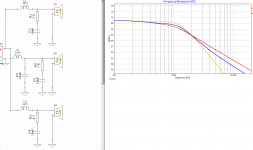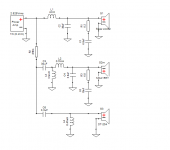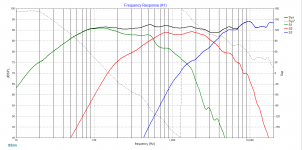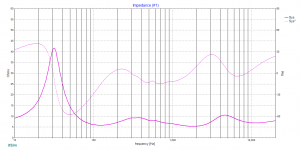See post 15 in this thread for one possible reason. The other is that each driver has a different impedance curve, and the optimal values (if choosing for traditional reasons of flattening the impedance to make textbook crossovers work better) for the zobel will differ from speaker to speaker.
Tony.
Tony.
Midrange is SEAS MCA15RCY, tweeter is Monacor DT-254. Crossover frequencies are 500Hz, 4Khz pure 2nd order filters in this 3-way speaker.
I used for Zobel at the midrange 1,5ohm+10uF because people and speaker designers mostly used these values. Somebody used 1,8 ohm+9,2uF other used 1,2ohm+8,2uF or 1,5ohm+12uF.
But according to an online calculator need 7,2ohm+14uF.
My question why people not used values according to the suggested calculation? Other question with my values I cannot damage the midrange or the amplifier? Am I safety?
What exactly the R and C influence? Is it really better to keep the suggested values or not?
Thank you.
I don't think those are zobels you are looking at, just a lifted parallel section of an even order crossover. There are inductors in front of those, correct?
Speaker is 3-way, crossover is so simple 2nd order.
Bass 10" low pass: 4mH+30uF, Zobel 8,2ohm+6,8uF
Midrange high pass: 30uF+3,5mH
low pass 0,5mH+3,9uF, Zobel 1,5ohm+10uF
Tweeter high pass: 3,3uF+0,47mH
Bass 10" low pass: 4mH+30uF, Zobel 8,2ohm+6,8uF
Midrange high pass: 30uF+3,5mH
low pass 0,5mH+3,9uF, Zobel 1,5ohm+10uF
Tweeter high pass: 3,3uF+0,47mH
Reducing the value of the resistor could be used to bring the circuit and the response somewhere between first and second order.
Thank you.
I made a simulation in Xsim but it is a very ideal case. Here the mod delay at all the 3 drivers are 0. What value I have to give them for mod delay?
Attachments
If you have measured your speakers and have used the proper techniques, you can leave the delay at 0.
If you have measured your speakers and have used the proper techniques, you can leave the delay at 0.
Unfortunately I cannot measure anything because I don't having any equipment.
But by ears really sounds well.
Passive crossover networks are constant k filters. The filter load aka the speakers impedance is needed to calculate the crossover frequency. If the impedance is flat purely resistivity filter shape and frequency are as calculated.Any speaker with a round voice coil has a rising impedance due to inductance and will alter the filters Q and shape. Zobel networks flatten impedance so the crossover network sees a more restrictive load. Having said all that I have used Zobel's in some of mt designs and some i haven't.
- Home
- Loudspeakers
- Multi-Way
- zobel vs impedance curve



